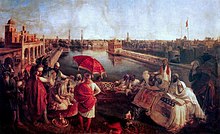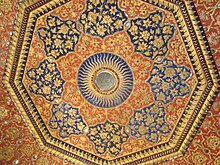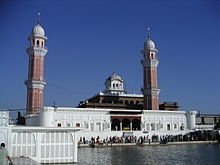27 AUG 1604 GURU GRANTH SAHIB ESTABLISHED
|
The Harmandir Sahib (The abode of God), informally known as the The Golden Temple |
History of Sri Harmandir Sahib (The Golden Temple) Amritsar |
Who donated land for Golden TempleThe bridge is connected with the 13 feet wide ‘Pardakshna’ (circumambulatory path). It runs round the main shrine and it leads to the ‘Har ki Paure’ (steps of God). On the first floor of "Har Ki Pauri", there is continuous reading of Guru Granth Sahib. The main structure of Sri Harmandir Sahib, functionally as well as technically is a three-storied one. The front, which faces the bridge, is decorated with repeated cusped arches and the roof of the first floor is at the height of the 26 feet and 9 inches. At the top of the first floor 4 feet high parapet rises on all the sides which has also four ‘Mamtees’ on the four corners and exactly on the top of the central hall of the main sanctuary rises the third story. It is a small square room and have three gates. A regular recitation of Guru Granth Sahib is also held there. On the top of this room stands the low fluted ‘Gumbaz’(dome) having lotus petal motif in relief at the base inverted lotus at the top which supports the "Kalash" having a beautiful "Chhatri" at the end. Its architecture represents a unique harmony between the Muslims and the Hindus way of construction work and this is considered the best architectural specimens of the world. It is often quoted that this architecture has created an independent Sikh school of architecture in the history of art in India. |
Harmandir Sahib
From Wikipedia, the free encyclopedia
| The Harmandir Sahib ਹਰਿਮੰਦਰ ਸਾਹਿਬ The Golden Temple | |
|---|---|

| |
| Alternative names | Darbar Sahib |
| General information | |
| Architectural style | Sikh architecture |
| Town or city | Amritsar |
| Country | India |
| Coordinates | 31°37′12″N 74°52′37″ECoordinates: 31°37′12″N 74°52′37″E |
| Construction started | December 1585 AD |
| Completed | August 1604 |
Sri Harmandir Sahib (The abode of God) (Punjabi: ਹਰਿਮੰਦਰ ਸਾਹਿਬ), also Sri Darbar Sahib (Punjabi: ਦਰਬਾਰ ਸਾਹਿਬ, Punjabi pronunciation: [dəɾbɑɾ sɑhɪb])[1] [3] and informally referred to as the "Golden Temple",[1] is the holiest Gurdwara of Sikhism, located in the city of Amritsar, Punjab, India. Amritsar (literally, the tank of nectar of immortality) was founded in 1577 by the fourth Sikh guru, Guru Ram Das.[4] The fifth Sikh Guru, Guru Arjan, designed the Harmandir Sahib to be built in the centre of this holy tank, and upon its construction, installed the Adi Granth, the holy scripture of Sikhism, inside the Harmandir Sahib.[1] The Harmandir Sahib complex is also home to the Akal Takht (the throne of the timeless one, constituted by the Sixth Guru, Guru Hargobind). While the Harmandir Sahib is regarded as the abode of God's spiritual attribute, the Akal Takht is the seat of God's temporal authority.[5]
The construction of Harmandir Sahib was intended to build a place of worship for men and women from all walks of life and all religions to come and worship God equally.[1][6] Accordingly, as a gesture of this non-sectarian universalness of Sikhism, Guru Arjan had specially invited Muslim Sufi saint, Hazrat Mian Mir to lay the foundation stone of the Harmandir Sahib.[7] The four entrances (representing the four directions) to get into the Harmandir Sahib also symbolise the openness of the Sikhs towards all people and religions.[8] Over 100,000 people visit the holy shrine daily for worship, and also partake jointly in the free community kitchen and meal (Langar) regardless of any distinctions, a tradition that is a hallmark of all Sikh Gurudwaras.[9]
The present-day gurdwara was rebuilt in 1764 by Jassa Singh Ahluwalia with the help of other Sikh Misls. In the early nineteenth century, Maharaja Ranjit Singh secured the Punjab region from outside attack and covered the upper floors of the gurdwara with gold, which gives it its distinctive appearance and its English name.[10]
Contents
[hide]History[edit]
The Harmandir Sahib literally means the Temple of God. Guru Amar Das had ordered Guru Ram Das to create a nectarous tank as a place for worship for the Sikh religion. Guru Ram Das instructed all his Sikhs to join in the work, under Bhai Budha's superintendence, and engaged labourers to assist them. He said that the tank of nectar should be God's home, and whoever bathed in it shall obtain all spiritual and temporal advantages. During the progress of the work, the hut in which the Guru first sheltered himself was expanded for his residence; it is now known as the Guru's Mahal, or palace.[11]
In 1578 CE Guru Ram Das excavated a tank, which subsequently became known as Amritsar (Pool of the Nectar of Immortality),[12] giving its name to the city that grew around it. In due course, the Harmandir Sahib,[13] was built in the middle of this tank and became the supreme centre of Sikhism. Its sanctum came to house the Adi Granth comprising compositions of Sikh Gurus and other saints considered to have Sikh values and philosophies, e.g.,Baba Farid, and Kabir. The compilation of the Adi Granth was started by the fifth guru of Sikhism, Guru Arjan.
Construction[edit]
Guru Arjan conceived the idea of creating a central place of worship for the Sikhs and designed the architecture of Harmandir Sahib. Earlier the planning to excavate the holy tank (Amritsar or Amrit Sarovar ) was chalked out by Guru Amar Das, the Third Sikh Guru, but it was executed by Guru Ram Das under the supervision of Baba Budha. The land for the site was acquired by the earlier Guru Sahibs on payment or free of cost from the Zamindars (landlords) of native villages. The plan to establish a town settlement was also made and the construction work on the Sarovar (the tank) and the town started simultaneously in 1570. The work on both projects was completed in 1577. In December 1588, Guru Arjan initiated the construction of the gurdwara and the foundation stone was laid by Hazrat Mian Mir on 28 December 1588.[14][15][16][16][17][18]
The gurdwara was completed in 1604. Guru Arjan installed the Guru Granth Sahib in it and appointed Baba Buddha as the first Granthi (reader) of it in August 1604. In the mid-18th century it was attacked by the Afghans, by one of Ahmed Shah Abdali's generals, Jahan Khan, and had to be substantially rebuilt in the 1760s. However, in response a Sikh Army was sent to hunt down the Afghan force. The forces met five miles outside Amritsar and Jahan Khan's army was destroyed.[19]
Operation Blue Star[edit]
Main article: Operation Blue Star
Blue Star was a military operation undertaken between 3 and 6 June 1984. The Indian prime minister Indira Gandhi ordered the Indian Army to launch the operation. The army, led by General Kuldip Singh Brar, brought infantry, artillery and tanks into the Harmandir Sahib to put a stop to the Dharam Yudh Morcha led by Jarnail Singh Bhindranwale. During the Dharam Yudh Morcha thousands of Sikhs courted arrest.[citation needed] Fierce fighting ensued between Sikhs and the army, with heavy casualties on both sides. The Harmandir Sahib complex also suffered much damage during the attack, especially the holy Akal Takht.[citation needed] Within six months, on 31 October 1984, Indira Gandhi's Sikh bodyguards killed her as revenge for the operation.
This attack is regarded by Sikhs, and the international human rights community[citation needed], as a desecration of Sikhism's holiest shrine and discrimination against a minority in India. In 1986, the repairs performed on the Akal Takht Sahib after the attack, which the Rajiv Gandhi government had undertaken without consultation[citation needed], were removed. A new Akal Takht Sahib was completed in 1999 by Kar Sevaks (volunteers).
Architectural features[edit]
Some of the architectural features of the Harmandir Sahib were intended to be symbolic of the Sikh world view.[20] Instead of the normal custom of building a gurdwara on high land, it was built at a lower level than the surrounding land so that devotees would have to go down steps to enter it.[20] In addition, instead of one entrance, Sri Harmandir Sahib has four entrances.[20]
The gurdwara is surrounded by the Sarovar, a large lake or holy tank, which consists of Amrit ("holy water" or "immortal nectar") and is fed by the Ravi River. There are four entrances to the gurdwara, signifying the importance of acceptance and openness. There are three holy trees (bers), each signifying a historical event or Sikh saint. Inside the gurdwara there are many memorial plaques that commemorate past Sikh historical events, saints and martyrs, including commemorative inscriptions of all the Sikh soldiers who died fighting in World War I and World War II.
Much of the present decorative gilding and marblework dates from the early 19th century. All the gold and exquisite marble work were conducted under the patronage of Hukam Singh Chimni and Emperor Ranjit Singh, Maharaja of the Sikh Empire of the Punjab. The Darshani Deorhi Arch stands at the beginning of the causeway to the Harmandir Sahib; it is 6.2 metres (20.3 ft) high and 6 metres (20 ft) in width. The gold plating on the Harmandir Sahib was begun by Ranjit Singh and was finished in 1830. Maharaja Ranjit Singh was a major donor of wealth and materials for the shrine.
The Harmandir Sahib complex also houses the Akal Takht (the throne of the timeless one), built by the sixth Sikh Guru, Guru Hargobind as an authority for administering justice and consideration of temporal issues. Within the complex, the Akal Takht constitutes a counterpoint with the holy shrine, in that the Harmandir Sahib is the abode of God's spiritual attribute, and the Akal Takht is the seat of God's temporal authority.[5]
Visiting guidelines[edit]
In keeping with the rule observed at all Sikh gurdwaras worldwide, the Harmandir Sahib is open to all persons regardless of their religion, colour, creed or gender. The only restrictions on the Harmandir Sahib's visitors concern their behaviour when entering and while visiting:
- Maintaining the purity of the sacred space and of one's body while in it:
- Upon entering the premises, removing one's shoes (leaving them off for the duration of one's visit) and washing one's feet in the small pool of water provided;
- Not drinking alcohol, eating meat, or smoking cigarettes or other drugs while in the shrine
- Dressing appropriately:
- Wearing a head covering (a sign of respect) (the gurdwara provides head scarves for visitors who have not brought a suitable covering);[21]
- Not wearing shoes (see above).
- How to act:
- When listening to Gurbani, one must also sit on the ground while in the Darbar Sahib as a sign of deference to both the Guru Granth Sahib and God.
First-time visitors are advised to begin their visit at the information office and then proceed to the Central Sikh Museum near the main entrance and clock tower.[tone]
The Harimandir Sahib runs one of the largest free kitchens in the world, serving 100,000 people on average daily. The meal consists of flat bread and lentil soup.[22]
Celebrations[edit]
One of the most important festivals is Vaisakhi, which is celebrated in the second week of April (usually the 13th). Sikhs celebrate the founding of the Khalsa on this day and it is celebrated with fervour in the Harmandir Sahib. Other important Sikh religious days such as the birth of Guru Ram Das, martyrdom day of Guru Teg Bahadur, the birthday of the Sikh founder Guru Nanak, etc., are also celebrated with religious piety. Similarly Diwali is one of the festivals which sees the Harmandir Sahib beautifully illuminated with Diyas (lamps); lights and fireworks are discharged. Most Sikhs visit Amritsar and the Harmandir Sahib at least once during their lifetime, particularly and mostly during special occasions in their life such as birthdays, marriages, childbirth, etc.
See also[edit]
Search Results
Parkash of Guru Granth sahib jee in DArbar SAhib (Golden temple ...
https://www.youtube.com/watch?v=QDVsfTfgkwg
May 15, 2010 - Uploaded by Ramandeep Singh
parkash of Guru Granth sahib g in Darbar sahib, Golden temple on 14 may 2010 on friday sangrand and ...Guru Granth Sahib Prakash every morning, Golden Temple , Amritsar ...
https://www.youtube.com/watch?v=MZ2-6gRtOjk
Mar 3, 2016 - Uploaded by Harpreet Singh
This is how every morning at around 4 AM, Guru Granth Sahib Prakash happens in Golden Temple , Amritsar.Prakash of Guru Granth Sahib at Golden Temple, Amritsar II - YouTube
https://www.youtube.com/watch?v=NxD7z6eEZo0
May 8, 2009 - Uploaded by Yogesh Mirpuri
Prakash (wake up ceremony) of Shri Guru Granth Sahib at The Golden temple, Amrisar. Filmed at ...Golden Temple Guru Granth Sahib Mind blowing View - YouTube
https://www.youtube.com/watch?v=PJ46rGwJsW8
May 18, 2016 - Uploaded by amit sharma
Golden Temple Guru Granth Sahib Mind blowing View. amit sharma ... Nita Ambani pays obeisance at Golden ...SANJHA NOOR: Sukhasan of Sri Guru Granth Sahib Ji at Golden ...
https://www.youtube.com/watch?v=LhQYcI8QCkY
Dec 10, 2014 - Uploaded by ABP Sanjha
SANJHA NOOR: Sukhasan of Sri Guru Granth Sahib Ji at Golden Temple, Amritsar ਡਿਠੇ ਸਭੇ ਥਾਵ ਨਹੀਂ ਤੁਧ ...Golden Temple Granth Sahib Ceremony - YouTube
https://www.youtube.com/watch?v=i6NbbyIG_FU
Feb 8, 2010 - Uploaded by Sinemaria
Amritsar, Punjub, India Guru Granth Sahib - sikh's holy book.Events for August 27 Golden Temple Of Amritsar Established ...
https://www.youtube.com/watch?v=8QEHYxzYa-U
22 hours ago - Uploaded by Top Historical Events
And provide the days observed in various countries on august . , guru granth sahib was established in the ...Prakash of Guru Granth Sahib at Golden Temple, Amritsar I - YouTube
https://www.youtube.com/watch?v=jsUtuN5XTaQ
May 8, 2009 - Uploaded by Yogesh Mirpuri
Prakash (wake up ceremony) of Shri Guru Granth Sahib at The Golden temple, Amrisar. Filmed at ...Golden temple guru granth sahib - YouTube
https://www.youtube.com/watch?v=UunsFzHuxnE
Mar 26, 2016 - Uploaded by dipdip
Golden temple guru granth sahib ... Daily Live Kirtan from Darbar Sahib Sri AmritSar from 2:30AM to 11:15PM ...Guru Granth Sahib @ Golden Temple,Amritsar - YouTube
https://www.youtube.com/watch?v=ixgyW_190Nw
Mar 11, 2013 - Uploaded by Subramaniam Dharana
The morning processional ceremony takes place at 4 a.m. in Summer and at 5 a.m. in Winter, when Sri Guru ...
Stay up to date on results for guru granth sahib established in the golden temple.
Create alert
Showing results for guru granth sahib established in the golden temple
Search instead for gurugrath sahib established in the golden temple
Search instead for gurugrath sahib established in the golden temple
Search Results
Harmandir Sahib - Wikipedia, the free encyclopedia
https://en.wikipedia.org/wiki/Harmandir_Sahib
Sri Harmandir Sahib (The abode of God) (Punjabi: ਹਰਿਮੰਦਰ ਸਾਹਿਬ), also Sri Darbar Sahib ... known as the Golden Temple ... The fifth Sikh Guru, Guru Arjan, designed the Harmandir Sahib to be built in the centre of this holy tank, and ... installed the Adi Granth, the holy scripture of Sikhism, inside the Harmandir SahibHistory of Golden Temple Amritsar History, History of Harmandir Sahib ...
www.goldentempleamritsar.org/history-of-golden-temple-amritsar.php
History of Golden Temple : The land was bought by the Guru Ram Das Sahib on ... Sahib installed newly created Guru Granth Sahib, in Sri Harmandir Sahib and ...Golden Temple, Amritsar, Sri Harmandir Sahib, Darbar Sahib, Hari ...
www.goldentempleamritsar.org/
The Golden Temple, Sri Harimandir Sahib is not only a central religious place of the ... located in Punjab, is the famous pilgrimage place for sikhs in India, Golden ... Sri Guru Granth Sahib (scripture of the Sikhs), after its compilation, was first ...
People also ask
Golden Temple - Sikh History
www.sikh-history.com/sikhhist/events/gtemple.html
Jan 10, 2004 - Read about Golden Temple at www.sikh-history.com. ... Amritsar was established by the Fourth Guru Guru Ramdas ji in 1589 A.D. There are many versions of .... The making of granthwas not easy and it took quite some time.History of Harmandir Sahib - Official Website of Shiromani Gurdwara ...
sgpc.net/history-of-harmandir-sahib/
Sri Harmandir Sahib, also known as Sri Darbar Sahib or Golden Temple, (on account of its ... Guru Arjan Sahib installed newly created Guru Granth Sahib, in Sri ...Golden Temple Amritsar History - Amritsar Portal
www.amritsar.com/Golden%20Temple%20History.shtml
Sri Harmandir Sahib Golden Temple Amritsar. ... Guru Amar Das Sahib, this city was founded byGuru Ram Das Sahib in 1574, on the land bought by him for an ...Guru Granth Sahib | SikhismGuide
www.sikhismguide.org/granth.aspx
Having compiled the Granth, the Guru placed it in the newly- built Harmandir Sahib (Golden Temple) in Amritsar. The first parkash (opening ceremony) was ...Historic Timeline of the Golden Temple and Akal Takhat - Sikhism
sikhism.about.com › ... › Sikh History and People › Historical Sikh Gurdwaras
The Golden Temple is situated in Amritsar, located in Northern Punjab, India, ... The Akal Takhat houses the Guru Granth Sahib between midnight and 3am ...Guru Granth Sahib - SikhiWiki, free Sikh encyclopedia.
www.sikhiwiki.org/index.php/Guru_Granth_Sahib
When one visits a Gurdwara (a Sikh temple), the Guru Granth Sahib forms the main .... words of love and humility, Mohan's heart was softened, and opened at last. ... The Adi Granth was completed in 1604, and installed in the Golden Temple; ...Harmandar Sahib - SikhiWiki, free Sikh encyclopedia.
www.sikhiwiki.org/index.php/Harmandar_Sahib
Aug 22, 2015 - 5 Plan of the Complex; 6 The Guru Granth and Harmandir Sahib ... has prohibited Sikhs from referring to the Sri Harmandir Sahib as the Golden Temple.) ... Amritsar is located in East Punjab at the North West border of India.Searches related to guru granth sahib established in the golden temple
Dahisar West, Mumbai, Maharashtra - From your search history - Use precise location







No comments:
Post a Comment